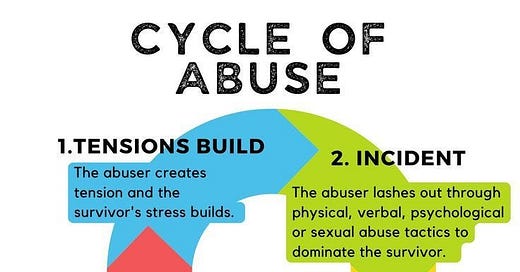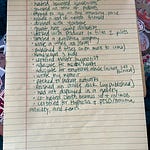The cycle of abuse is a repeating pattern that many abusive relationships follow. It’s not constant violence or cruelty, that’s part of what makes it so confusing and hard to escape. It often includes periods of love and peace, which can make the abuse feel like a bad moment in an otherwise “good” relationship, but those moments don’t mean the abuse isn’t real.
Tension Building: This is when things start to feel “off.” The abuser might seem irritable, critical, or moody. The person being abused often walks on eggshells, trying to keep the peace, avoid conflict, or “fix” the situation before it gets worse. They may feel anxious, responsible, or afraid, without always knowing why.
To outsiders, this stage might just look like stress or a bad mood, but inside the relationship, it feels like holding your breath all of the time.
2. Incident (The Abuse): This is when the actual abuse happens. It could be:
Verbal: Yelling, name-calling, gaslighting
Emotional: threats, blame, silent treatment
Physical: hitting, pushing, blocking exits
Sexual coercion or assault
Financial, digital, or other forms of control
This is the part people usually think of when they hear “abuse,” but it’s only one part of the cycle.
3. Reconciliation (The “Makeup” Phase): After the blowup, the abuser often apologizes or gives excuses. They may cry, buy gifts, promise to change, or say things like “I only did that because I love you so much.” Sometimes they shift the blame to the victim by saying things like, “If you hadn’t said that, I wouldn’t have reacted that way.”
This stage is full of confusing hope. The victim may start to believe the worst is over.
4. Calm (The Honeymoon Phase): Things go back to “normal,” or even become better than normal. The abuser may act loving, affectionate, and kind. The person being abused may start to doubt themselves, “Maybe it really wasn’t that bad.” They might stay in the relationship because it feels like the abuse is over.
But the cycle almost always starts again.
I thought I had escaped the cycle, and for a while, with firm boundaries, I did, but not completely. I wish I had understood the cycle of abuse years ago. It would have explained so much about my marriage and the patterns I adapted to survive.
Why People Stay?
To someone outside the situation, it might seem obvious: “Why not just leave?” But when love, fear, confusion, and trauma are all tangled together, it’s not that simple.
The good times feel real, and they are. That’s what makes the bad times so disorienting. Abusers aren’t abusive every day.
The abuser often isolates their victim, making it hard to reach out or to believe they have other options.
Over time, the cycle of abuse wears down the victim's sense of self, confidence, and reality. The cycle of abuse isn’t about constant cruelty; it’s about control, confusion, and keeping someone tied to the relationship through fear, hope, and trauma. The more we understand this, the better we can support survivors with compassion instead of judgment.
If this resonated with you, know that you are not alone. The cycle of abuse is real, and it thrives in silence. You are not weak for staying — you were surviving.
If you’re ready to start rebuilding your sense of self, I offer trauma-informed hypnotherapy and tarot-based clarity sessions that support survivors in reclaiming their voice, their trust, and their future.
Subscribe for more healing resources
Follow on Instagram @karly.latham










Share this post